Native Plants Have Moa Defences - Scientists
Scientists say native plants have anti-moa defences
A Landcare Research ecologist and a South African botany professor have used emus and ostriches to show that New Zealand native plants have adapted to protect themselves from the ravages of hungry moa. Their findings could have significant conservation implications.
About ten percent of our native shrubs and trees are divaricate - a rare form in all other countries. These plants, like some Coprosmas, have small, widely spaced leaves on wiry interlaced branches that grow in zig-zag directions. The strength of these thin branches is unique to New Zealand. Some divaricate plants like lowland ribbonwood and kowhai change form as they mature, starting life with tough, shrubby divaricate growth, and then swapping to straighter branches and bigger leaves from about two and a half metres high.
Some scientists believe these forms are adaptations to extreme climate conditions. But Landcare Research scientist Dr Bill Lee and Professor William Bond from Cape Town University say that the very strong branches and small leaves are defences against browsing moa. They believe the birds fed by plucking or stripping leaves and clamping and tugging shoots. The thin convoluted branches also create a zig-zag pattern that produce a spring-like recoil when tugged. All of these features reduced the moa's ability to remove plant material. Dr Lee and Professor Bond say most moa beaks did not have a secateur action, and therefore could not cut through branches and shoots. The larger leaves and easier-to-snap branches only appear from about 2.5 metres up the tree, above the reach of most browsing moa.
In the absence of moa, the pair decided to run experiments with close living relatives, namely emus and ostriches available on farms in Otago. They used them as a surrogate for moa, as they are a similar size to some species of moa, although their beaks are not as blunt.
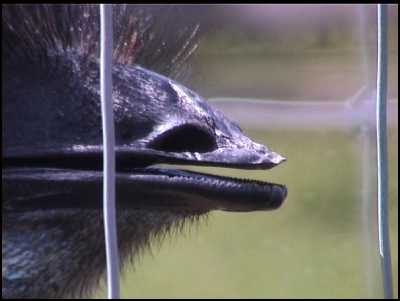
The sharp end of it
Using well-tested procedures developed in Africa to look at the defences of spiny acacia against large mammals such as giraffes, the scientists fed the emus and ostriches typical juvenile shoots from wiry divaricate plants, as well as adult-phase material from high in the canopy. The juvenile foliage survived the ravages of the emus and ostriches relatively unscathed, whereas the adult foliage and branches were stripped bare.
"It took the birds six to seven times longer to eat the juvenile foliage than it did to eat the adult foliage" says Professor Bond. "At that rate, emus and ostriches would need to eat for 40 hours a day to get the food they need. In the wild, they would simply have to give up on such plants and move on".
The same plants were fed to a goat. These animals with their strong biting action, large muscular tongue and flexible lips readily demolished the divaricate plants which withstood the attempted ravages by emus and ostriches.
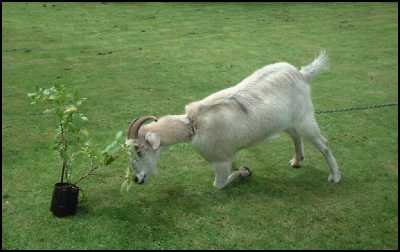
Chomping at the bit : Billy the goat
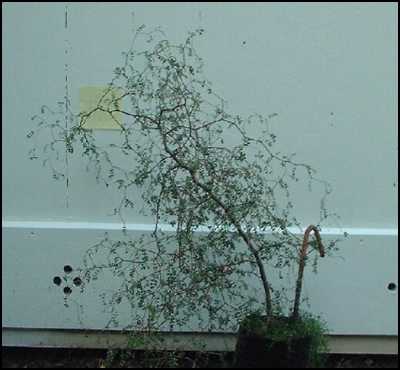
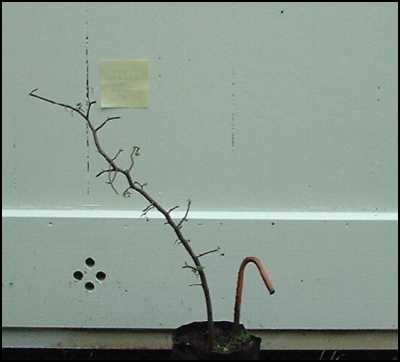
before & after: goat
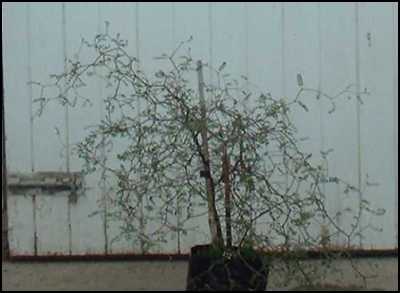
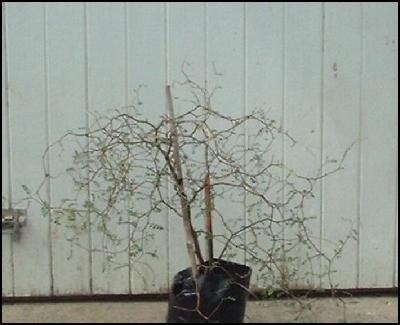
before & after:
emu
The theory that some native woody plants have developed anti-moa defences is not new. In 1977, Michael Greenwood and Ian Atkinson developed the idea that the characteristic cage-like structure of divaricates limited the impact of moa foraging. Their views were controversial and disputed by some scientists who claimed that divaricates' small leaves within a dense twiggy canopy were a defence against frost and wind, and that trees that change shape half way up do so in response to climatic changes.
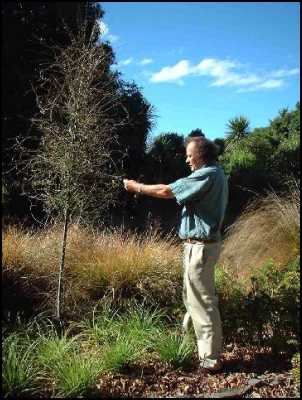
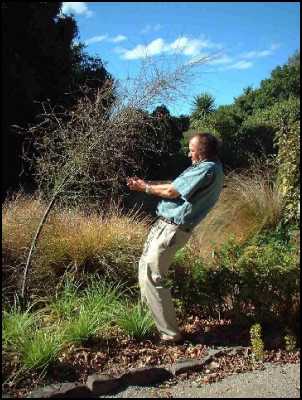
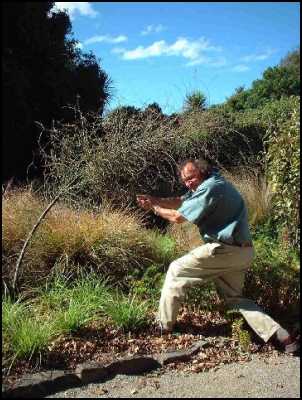

Professor William Bond and a display of strength - by the narrow-leaved lacebark tree, that is. One very thin wiry branch (about 2mm) is strong enough to pull the entire tree over. But tensile strength is not the same as hardness - the branches are defenceless against the teeth of browsers like goats and deer.
But Professor Bond thinks otherwise. "We believe that although weather patterns are a factor, these plants evolved primarily as protection against moa feeding. Back in the seventies, Atkinson and Greenwood did not have access to emu and ostrich farms, so they were not able to demonstrate the link and mechanism as thoroughly as we have".
Dr Lee says as well as shedding new light on the moa's role in the environment, the findings have important conservation implications for today. " If plants in New Zealand have adapted to protect themselves against tugging rather than cutting, they will be especially vulnerable to mammalian browsers, like deer and goats".
"Another question this study raises is whether moa feeding performed useful functions that we should look at restoring, if we want to return these wiry plants to native ecosystems. For example, should we introduce emus and ostriches to some protected natural forest or scrubland areas to restore important biotic processes?"
Professor Bond has other reasons as well for finding interest in this study. "The moa is the most recent large-animal extinction in the world: it only died out three or four hundred years ago. The last large-animal extinctions before that happened three to four thousand years ago. New Zealand's plant life is unique, and is still adapting to life without the moa.
"We must get interested in the moa again. We owe it to the poor bird".
ENDS For more information, contact: Dr Bill Lee Landcare Research Dunedin wk: (03) 477 4050 hm: (03) 467 9260 LeeW@landcare.cri.nz
Professor William Bond University of Cape Town South Africa (wk) (0027) 21 650 2447 or (0027) 35 562 0255 x214 bond@botzoo.uct.ac.za


 University of Auckland: Protecting Young Minds With AI
University of Auckland: Protecting Young Minds With AI Greenpeace: Greenpeace Calls On Fonterra Investors To Consider Big Picture With Giant Puzzle
Greenpeace: Greenpeace Calls On Fonterra Investors To Consider Big Picture With Giant Puzzle Hugh Grant: How New Tech Helps Kids Love Soccer More
Hugh Grant: How New Tech Helps Kids Love Soccer More Bill Bennett: Download Weekly - 100% claim lands One New Zealand in criminal court action
Bill Bennett: Download Weekly - 100% claim lands One New Zealand in criminal court action FSCL: Woman Scammed Out Of $25,000 After Job Offer On LinkedIn
FSCL: Woman Scammed Out Of $25,000 After Job Offer On LinkedIn NIWA: Cheers To Crustaceans - New Species Named After Welly Brewery
NIWA: Cheers To Crustaceans - New Species Named After Welly Brewery



